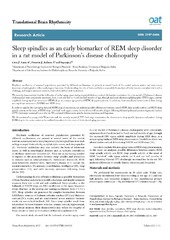Приказ основних података о документу
Sleep spindles as an early biomarker of REM sleep disorder in a rat model of Parkinson’s disease cholinopathy
| dc.creator | Ćirić, Jelena | |
| dc.creator | Lazić, Katarina | |
| dc.creator | Petrović, Jelena | |
| dc.creator | Kalauzi, A | |
| dc.creator | Šaponjić, Jasna | |
| dc.date.accessioned | 2019-03-26T13:07:41Z | |
| dc.date.available | 2019-03-26T13:07:41Z | |
| dc.date.issued | 2017 | |
| dc.identifier.uri | http://www.oatext.com/sleep-spindles-as-an-early-biomarker-of-rem-sleep-disorder-in-a-rat-model-of-parkinsons-disease-cholinopathy.php | |
| dc.identifier.uri | https://radar.ibiss.bg.ac.rs/handle/123456789/3296 | |
| dc.description.abstract | Rhythmic oscillations of neuronal populations, generated by different mechanisms, are present at several levels of the central nervous system and serve many important physiological or reflect pathological functions. Understanding the role of brain oscillations as possible biomarkers of brain function and plasticity is still a challenge, and despite extensive research, their role is still not well established. We recently demonstrated that the hallmarks of earlier aging onset during impaired thalamo-cortical cholinergic innervation (in a rat model of Parkinson’s disease cholinopathy) were consistently expressed, from 3 and one half to 5 and one half months of age, through increased electroencephalographic (EEG) sigma activity amplitude during rapid eye movement (REM) sleep, as a unique aging induced REM sleep phenomenon. In addition, there was altered motor cortical drive during non-rapid-eye-movement (NREM) and REM sleep. In order to explain this new aging-induced REM sleep phenomenon, we analyzed possible differences between control REM sleep spindle activity and REM sleep spindle activity at the onset of REM sleep “enriched“ with sigma activity (at 4 and one half months of age), following bilateral pedunculopontine tegmental nucleus (PPT) cholinergic neuronal loss in the rat. We analzyed differences in spindle density, duration, and frequency. We demonstrated in young adult Wistar rats with the severely impaired PPT cholinergic innervation the alterations in sleep spindle dynamics and pattern during REM sleep in the motor cortex as the earliest biomarkers for the onset of their altered aging processes. | en |
| dc.relation | info:eu-repo/grantAgreement/MESTD/Basic Research (BR or ON)/173022/RS// | |
| dc.rights | openAccess | |
| dc.rights.uri | https://creativecommons.org/licenses/by/4.0/ | |
| dc.source | Translational Brain Rhythmicity | |
| dc.subject | Sleep spindles | |
| dc.subject | Oscillations | |
| dc.subject | REM sleep disorder | |
| dc.subject | Pedunculopontine tegmental nucleus | |
| dc.subject | Parkinson’s disease | |
| dc.subject | Cholinopathy | |
| dc.title | Sleep spindles as an early biomarker of REM sleep disorder in a rat model of Parkinson’s disease cholinopathy | en |
| dc.type | article | en |
| dc.rights.license | BY | |
| dcterms.abstract | Ћирић, Јелена; Лазић, Катарина; Петровић, Јелена; Шапоњић, Јасна; Калаузи, A; | |
| dc.rights.holder | © 2017 Ciric J. | |
| dc.citation.issue | 1 | |
| dc.citation.volume | 2 | |
| dc.identifier.doi | 10.15761/TBR.1000111 | |
| dc.citation.apa | Ciric, J., Lazic, K., Petrovic, J., Kalauzi, A., & Saponjic, J. (2017). Sleep spindles as an early biomarker of REM sleep disorder in a rat model of Parkinson’s disease cholinopathy. Translational Brain Rhythmicity, 2(1), 1–11. | |
| dc.citation.vancouver | Ciric J, Lazic K, Petrovic J, Kalauzi A, Saponjic J. Sleep spindles as an early biomarker of REM sleep disorder in a rat model of Parkinson’s disease cholinopathy. Transl Brain Rhythm. 2017;2(1):1–11. | |
| dc.citation.spage | 1 | |
| dc.citation.epage | 11 | |
| dc.type.version | publishedVersion | en |
| dc.identifier.fulltext | https://radar.ibiss.bg.ac.rs//bitstream/id/4881/TranslBrainRhythm_2017_2_1_1-11.pdf |

